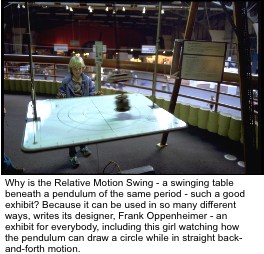The Exploratorium - or any good museum - is a response to the problems that beset both my guided tours in the mountains, and teachers who feel they must "cover the ground." At the Exploratorium we've invented a new style of exhibit to do it. Interchangeable Links in Common Chains Consider our audience as contemplating a tree. Science museums all describe themselves as having interactive, involving, hands-on exhibits. But they misunderstand the implication of the terms they use. A tree has no pushbuttons, no cranks, no manipulative parts; but there are a lot of ways of interacting with it. One can look at it, lie under it, climb and feel it. One can watch the leaf buds unfold, mature into deepening greens and then oranges and reds until they fall off. One can study the bark, the cambium layer, the root hairs; extract sap; learn about photosynthesis. One can hear the rustle and watch the swaying in the wind. One can draw or photograph the tree, carve initials on it, chop it down, or just stand and watch the sunlight diffract around the edges of the leaves. One can even learn its name. Our exhibits do not have quite this versatility. For one thing, we do not want people to chop them down; for another, the time scale is more defined: at most, half an hour at any one exhibit piece, often much less. More importantly, however, we conceive most of our exhibit pieces as props to link a pedagogical chain; frequently the links are common to several different chains. Thus, the Relative Motion Swing, which has a swinging table beneath a pendulum of the same period, can be used in many contexts. One can use it in talking about vectors, about polarized light, about Lissajous figures, about phase, amplitude and frequency, about damping, about kinetic and potential energy, about frame of reference and relative motion. For each of these topics this exhibit is but one link shared by several other chains of exhibits, which may intersect at other links as well. |  | ||||
| The fact that we use this exhibit for these multiple but specific purposes limits the versatility of people's interactions with it, but not as severely as one might imagine.. True, visitors cannot disassemble and rebuild the exhibit. True, we have not made provision for the visitor to vary the swing periods of the table or the pendulum. (The clearest pedagogy arises when the two motions swing synchronously. If either were readily adjustable, most visitors would not take the time to make the two motions synchronous and thus would not perceive the most delightful effects of relative motion.) On the other hand, we have not designed out all possibilities of variation. Although the pendulum swings most readily at right angles to the table, it can also swing parallel to the motion of the table with a very different and not commensurate period. The table itself can be made to vibrate perpendicular to its swing and, thereby, modulate the basic pattern of relative motion. People use this exhibit in many different ways. Some just give the table a push as they walk by but then, so do I. Others make everything move every which way producing a noisy, unintelligible relative motion pattern. I enjoy doing that too. Many people very systematically let the table and the pendulum swing at right angles to each other, trying to reproduce the indicated circles and diagonal | |||||